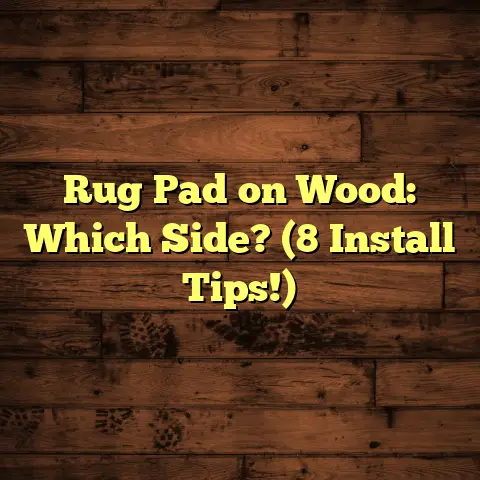Clean Cat Litter Dust Off Tile? (1-Day Fix!)
It’s a real pain, not just because it’s unsightly, but because it can affect your indoor air quality.
Don’t worry, though! I’m going to share my pro secrets to tackle that dusty mess, and you can totally do it in a day. Let’s get started!
Section 1: Budget Options for Cat Litter Management
Overview of Cat Litter Dust Issues
Okay, let’s be real: some litters are just dustier than others. Clay litter, especially the cheaper kinds, is notorious for kicking up a cloud every time your cat digs.
Ever notice that fine, white powder coating everything near the litter box? That’s it.
This dust isn’t just annoying; it can be a respiratory irritant for both you and your furry friend.
Plus, it settles on your tile floors, making them look grimy and dull.
Low-Cost Cat Litter Alternatives
Good news! You don’t have to break the bank to find less dusty options.
-
Recycled Paper Litter: This is my go-to recommendation for budget-conscious folks. It’s made from recycled paper, so it’s eco-friendly.
It’s also surprisingly absorbent and produces significantly less dust than clay.
Cost: Usually around $15-$25 for a large bag.
-
Wood Pellet Litter: Made from compressed sawdust, this litter is super absorbent and has a natural pine scent.
It’s great for controlling odors and is very low dust.
Cost: Typically $10-$20 for a large bag.
-
Corn-Based Litter: This is another natural option that’s low in dust and biodegradable. It clumps well and controls odors effectively.
Cost: Expect to pay around $20-$30 for a large bag.
Here’s a quick comparison table:
| Litter Type | Dust Level | Odor Control | Cost (approx.) |
|---|---|---|---|
| Clay | High | Moderate | $5-$15 |
| Recycled Paper | Low | Good | $15-$25 |
| Wood Pellet | Very Low | Excellent | $10-$20 |
| Corn-Based | Low | Excellent | $20-$30 |
DIY Solutions
Want to save even more money? Try these DIY tricks:
-
Baking Soda: Sprinkle a thin layer of baking soda at the bottom of the litter box before adding litter.
It helps absorb odors and can reduce dust.
-
Essential Oils: Add a few drops of pet-safe essential oils (like lavender or chamomile) to the litter box for a pleasant scent.
Just make sure they’re diluted and safe for cats! Always do your research.
-
Vinegar: A diluted vinegar solution (1 part vinegar, 1 part water) can be used to clean the litter box.
It’s a natural disinfectant and helps eliminate odors.
Important note: Always consult with your vet before introducing any new substances or scents to your cat’s environment.
Investing in Cat Litter Boxes
The right litter box can make a huge difference in dust control.
-
Covered Litter Boxes: These help contain dust and litter scatter. Look for ones with a filter to trap odors.
Cost: $20-$50
-
Litter Boxes with Built-in Air Filters: Some high-end litter boxes have built-in air filters that help remove dust and odors.
Cost: $50-$150
-
Top-Entry Litter Boxes: These boxes force your cat to jump in and out, which helps reduce tracking.
Cost: $30-$60
Budget Cleaning Supplies
You don’t need fancy, expensive cleaners to tackle litter dust. Here are my go-to budget options:
-
Microfiber Mops: These are amazing for picking up dust and dirt without scratching your tile.
Cost: $10-$20
-
Eco-Friendly Cleaners: Look for cleaners that are non-toxic and safe for pets.
Cost: $5-$15 per bottle
-
Homemade Cleaning Solutions: A mixture of vinegar and water (1:1 ratio) works wonders on tile floors.
Add a few drops of dish soap for extra cleaning power.
Section 2: Preparation for Cleaning
Gathering Your Supplies
Before you start, make sure you have everything you need. Here’s my checklist:
- Broom: For sweeping up loose litter and dust.
- Vacuum Cleaner: Ideally with a HEPA filter to trap fine dust particles.
- Microfiber Mop: For damp mopping.
- Bucket: For your cleaning solution.
- Cleaning Solution: Either a store-bought eco-friendly cleaner or a homemade solution.
- Spray Bottle: For spot cleaning.
- Old Rags or Sponges: For scrubbing stubborn stains.
- Gloves: To protect your hands.
You can find most of these items at your local dollar store or discount retailer.
Safety Precautions
Safety first!
-
Pet-Safe Cleaners: Always use cleaning products that are safe for pets. Avoid anything with harsh chemicals like bleach or ammonia.
-
Ventilation: Open windows or turn on a fan to ensure good ventilation during the cleaning process.
-
Keep Pets Away: Keep your cats (and other pets) away from the cleaning area until the floor is completely dry.
Preparing the Area
Now, let’s get the area ready for cleaning:
- Move Furniture: Move any furniture, rugs, or other items that are in the way.
- Remove Loose Litter: Use a broom or vacuum to remove any loose litter or debris from the floor.
- Protect Other Areas: Place old towels or sheets at the edges of the cleaning area to prevent the cleaning solution from spreading to other rooms.
Section 3: Cleaning Methodology
Alright, let’s get down to the nitty-gritty. Here’s my step-by-step guide to cleaning cat litter dust off tile floors:
Step-by-Step Cleaning Process
-
Initial Dusting and Sweeping:
- Start by sweeping the entire area to remove any loose dust, litter, and debris. Pay special attention to corners and edges.
- Use a broom with soft bristles to avoid scratching your tile.
-
Vacuuming Techniques:
- Use a vacuum cleaner with a HEPA filter to remove fine dust particles. HEPA filters are designed to trap tiny particles, including allergens and pet dander.
- Vacuum the entire area thoroughly, paying attention to grout lines, where dust tends to accumulate.
- Use the vacuum’s crevice tool to get into hard-to-reach areas, like corners and edges.
-
Mopping Tips:
- Fill your bucket with warm water and your chosen cleaning solution.
- Homemade Solution: Mix 1 part white vinegar with 1 part warm water. Add a few drops of dish soap for extra cleaning power.
- Dip your microfiber mop into the cleaning solution and wring it out thoroughly. You want the mop to be damp, not soaking wet.
- Mop the floor in overlapping strokes, making sure to cover the entire area.
- Rinse the mop frequently in clean water to remove dirt and grime.
- For heavily soiled areas, let the cleaning solution sit on the floor for a few minutes before mopping.
- Fill your bucket with warm water and your chosen cleaning solution.
-
Spot Cleaning Stains:
- If you have any stains from cat litter, use a spray bottle to apply a small amount of cleaning solution directly to the stain.
- Let the solution sit for a few minutes, then scrub the stain with an old rag or sponge.
- For stubborn stains, try using a paste of baking soda and water. Apply the paste to the stain, let it sit for 15-20 minutes, then scrub and rinse.
Drying and Finishing Touches
- Allow the Floor to Dry: Once you’ve finished mopping, allow the floor to dry completely. Open windows or turn on a fan to speed up the drying process.
- Preventing Further Dust Accumulation:
- Place a mat or rug near the litter box to catch litter and dust.
- Regularly sweep or vacuum the area around the litter box.
- Consider using an air purifier with a HEPA filter to remove dust and allergens from the air.
Section 4: Maintenance Tips for Long-Term Cleanliness
Cleaning is just the first step. Here’s how to keep your tile floors dust-free in the long run:
Regular Cleaning Schedule
- Daily: Sweep or vacuum the area around the litter box to remove loose litter and dust.
- Weekly: Mop the entire tile floor with a pet-safe cleaning solution.
- Monthly: Deep clean the grout lines with a grout brush and a solution of baking soda and water.
Cat Litter Box Maintenance
- Regular Emptying: Empty the litter box at least once a day to prevent odors and dust buildup.
- Thorough Cleaning: Clean the litter box thoroughly at least once a month with a diluted vinegar solution.
- Right Location: Place the litter box in a well-ventilated area to help reduce odors and dust.
Grooming Your Cat
- Regular Brushing: Brush your cat regularly to remove loose fur and dander. This will help reduce the amount of dust and allergens in your home.
- Consider Bathing: If your cat tolerates it, consider bathing them occasionally to remove excess dander. Use a pet-safe shampoo.
Air Quality Improvement
- Air Purifiers: Use an air purifier with a HEPA filter to remove dust, allergens, and odors from the air.
- Ventilation: Open windows regularly to improve ventilation and reduce indoor air pollution.
- Indoor Plants: Certain indoor plants, like spider plants and snake plants, can help purify the air.
Section 5: Troubleshooting Common Issues
Even with the best efforts, you might still encounter some problems. Here’s how to troubleshoot them:
Persistent Dust Problems
- Check Your Litter: If you’re still experiencing a lot of dust, try switching to a different type of litter.
- Improve Ventilation: Make sure the area around the litter box is well-ventilated.
- Clean More Frequently: Increase the frequency of your cleaning routine.
Choosing the Right Litter
- Consider Your Cat’s Preferences: Some cats are picky about their litter. Experiment with different types to find one that your cat likes.
- Long-Haired Cats: Long-haired cats may benefit from litters that are less likely to stick to their fur.
- Allergies: If you or your cat have allergies, choose a hypoallergenic litter.
Conclusion
So, there you have it! My comprehensive guide to cleaning cat litter dust off tile floors. It might seem like a lot, but trust me, with a little effort and the right tools, you can achieve a dust-free environment in just one day.
Remember, maintaining clean tile floors is not just about aesthetics; it’s about the health and well-being of both you and your furry friends.
By implementing the steps outlined in this article, you can create a cleaner, healthier, and happier home for everyone. Good luck!





